enrollment
Equitable Engagement: Addressing Gaps in Access to Information With Students and Families
We know that the college planning process is an intensive one for students and families, but how do they perceive the process? What are their needs, expectations, and challenges as they research potential schools? This was what we wanted to explore when we launched two studies this year:
- Prospective Family Engagement (conducted with CampusESP and Ardeo Education Solutions)—a survey of 6,400 families of prospective college students.
- High School Student Perceptions of Financial Aid (conducted with Ardeo Education Solutions and PLEXUSS)—a study conducted with 1,250 11th– and 12th-grad students.
We uncovered a ton of great insights on communications, search behaviors, cost and financial aid, and much more. But there were a few eye-opening findings even for me—someone who has both conducted recruitment research for RNL for years and who had a daughter go through the college search process. In particular, it was interesting to see how much families want to be involved and how there involvement makes a huge difference with students as they search for college.
Families of prospective college students are involved, and they want to hear from institutions
First, it’s important to know how involved families are and how eager they are to hear from you. In High School Student Perceptions of College Financing, students said that nine out of 10 parents or guardians are involved in college planning in the 11th grade; the same proportion also said families have reviewed the financial aid award letters their students have received. Furthermore, by the 11th grade, 70 percent have discussed how they are going to finance their student’s education.
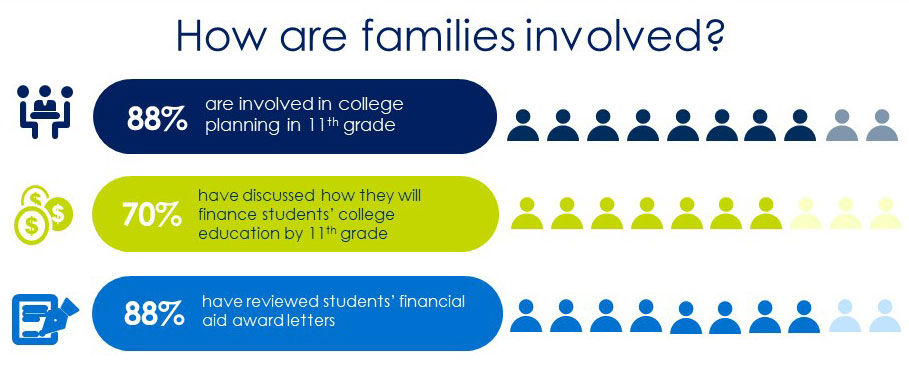
So it’s clear that you should include families in your communications. But here’s a great finding: many families want to hear from you on a weekly basis! That number has jumped more than 20 points in the last two years from our previous studies.
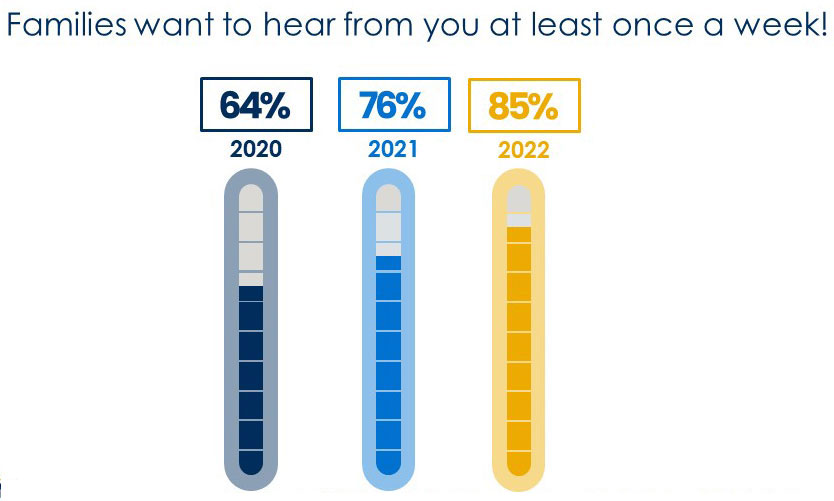
Family involvement shapes a student’s perception of college planning
Engaging families is important because they are major enrollment influencers. However, involving parents and guardians does more than keep them engaged with your institution. It makes a difference in how students perceive and feel about all aspects of the college planning process. When we looked at the data from our studies, we saw students whose families are involved in college planning had a number of advantages, including:
- Less likely to think paying for college would be difficult
- Less likely to have fears about borrowing
- Better access to college planning information
- More satisfied with information about financial aid
- Fewer fears of being admitted
- More likely to be interested in out-of-state institutions
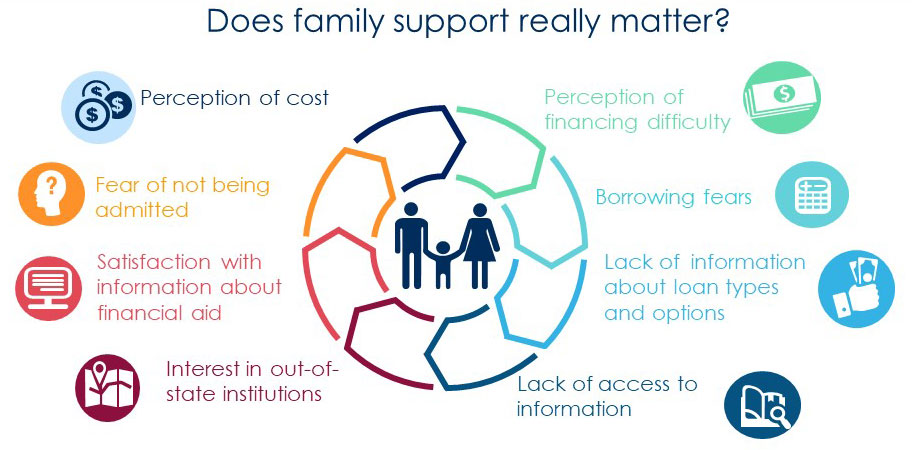
Unfortunately, students without family involvement have the opposite experience, and it is heartbreaking that students who go through the college planning process on their own are more likely to think it will be difficult to pay for college, do not tend to have better access to college planning information, and are more likely to think they will not be admitted. This illustrates that it is important to find out if families are involved in planning not only to engage them, but to identify which students are going through the process on their own so you can make sure they have the resources and support they need to research college. Even though nearly 90 percent of students say their families are involved, that still leaves a large number of students going it alone in your pool.
Access to college planning information is not equitable
Another discover during our family engagement research was the lack of equity surrounding college planning information. Families with first-generation prospective college students, families of color, and families with less household income were less likely to report having access to key information and resources.
First, it’s important to know what information families want to learn. Here were the top 10 information topic (these were all identified as desired topics by the vast majority of families):
- Academics (programs, majors, etc.)
- Admission requirements
- Strength of academic programs (ratings/rankings)
- Cost (tuition, room and board, fees)
- Housing
- Safety precautions
- Financing options
- Application process and timeline
- Financial aid and scholarships
- Location information (campus, town, local area)
We also asked if families recalled accessing/retrieving information about these topics. Again and again, families with students who were first-generation or who had lower household income levels did not have access to this information as much as other families. There were also significant differences by ethnicity as well. Consider these three areas about cost, financial aid, and financing. The percentages are the number of families who recalled accessing information on the topic (all data are from 2022 High School Student Perceptions of College Financing).
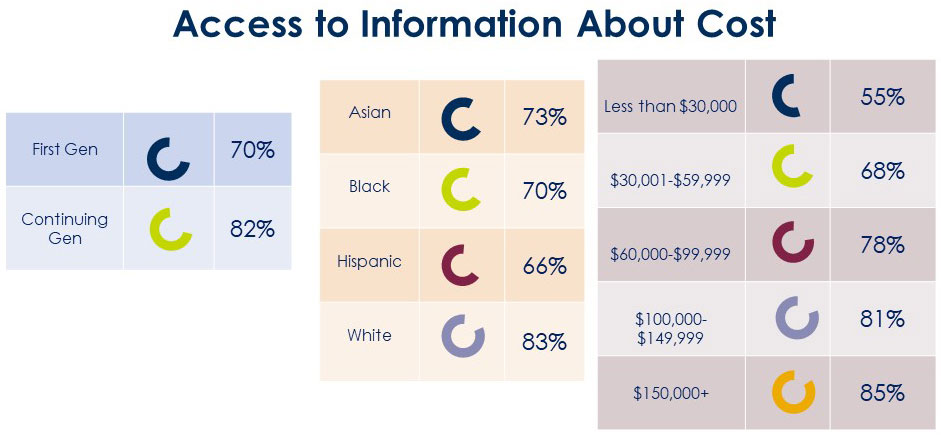
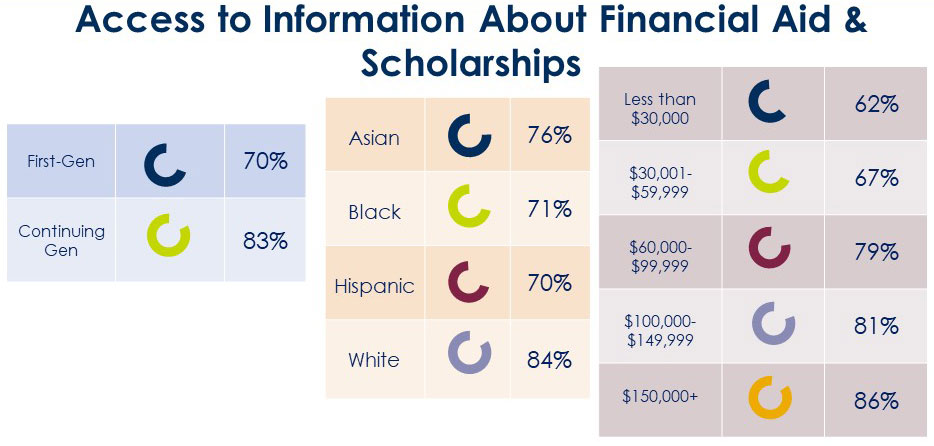
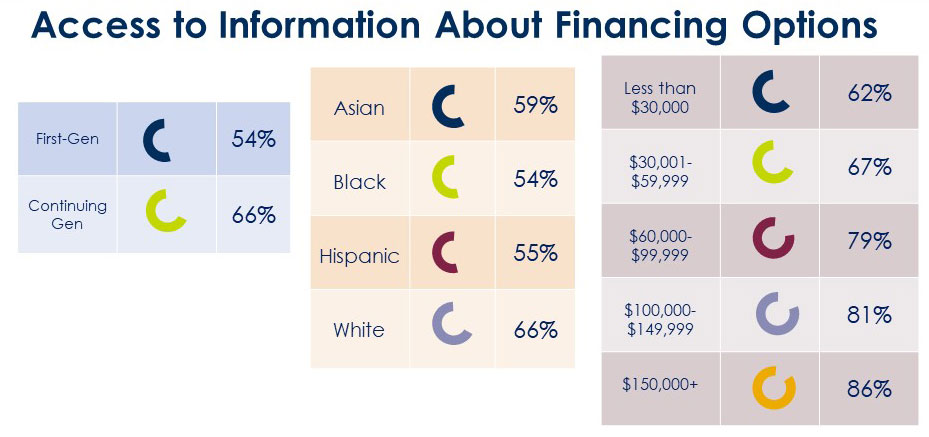
5 Ways to Engage Families and Promote Equitable Access to Information
1. Collect family contact information early and create real engagement with families. Most institutions do collect family information, but a “family campaign” may just involve sending a bit of mail of emails. You need to engage families the way you would students, across multiple channels and in particular reaching parents via their mobile devices. Giving families the ability to opt-in to text messages for instance is a great way to keep them informed of key deadlines, events, and resources.
2. Simplify messaging so it explains things clearly. This is especially true for complex topics such as cost and financial aid. Review your communications to families and students to remove jargon and technical terms while explaining things clearly. Ask yourself if you knew nothing about the enrollment process, would you understand what you are reading?
3. Demystify “cost” and “price.” Many families will eliminate an institution based on the perception of price—without necessarily understanding what their actual cost to attend is. It’s important to let families and students know all the ways they can finance an education and the ROI they can expect from getting a college degree. It will help them understand education as an investment vs. an expense.
4. Work on continuous improvement to close information gaps. Understanding that different families and student populations may have challenges accessing information can help you close those gaps. Keep in mind that for many families, they have may challenges with internet access, not have a computer, or have other issues accessing information.
5. Incorporate diverse student and family generated content and testimonials. Finally, in the information you do provide, show diversity of perspectives and experiences. Have content by and for first-generation families and families from a variety of backgrounds so a wider variety of students can see your institution is a good fit for them.
Read the reports and reach out to talk to us about your marketing and recruitment strategies
You can download these reports now from the RNL Resource Library:
We can also discuss your marketing and recruitment strategies to help you build connections with a variety of student populations and make sure they are engaged at every enrollment stage. Contact us today and we will set up a time to talk.
Engage families throughout the college planning process
Parents and family members can be your biggest enrollment champions. They are the number-one influencers for prospective students. That’s why RNL Student Search to Enrollment makes parent engagement a major part of search campaigns.
Ask for a for a free walkthrough and see how you can engage students and parents at every stage of the enrollment journey.
